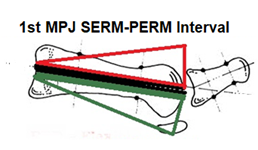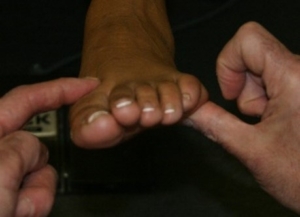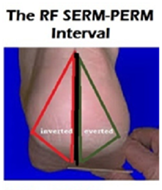©2023 – Dr Dennis Shavelson – FootHelpers | concept by www.thewriteonecs.com
SERM-PERM Testing
 Human joints have two tri-plane motions in opposite directions called Supination and Pronation each with an endpoint. The Supination endpoint is the Supinatory End Range of Motion or SERM and the Pronatory endpoint is the Pronatory End Range of Motion or PERM. The motion between SERM and PERM is known as SERM-PERM Interval (see image). Movement within the SERM-PERM Interval is efficient and injury-free and SERM and PERM is where both stability and deterioration begin. SERM-PERM Testing is the new diagnostic Biomechanical Testing method for Foot Centering Biomechanics and is easy to learn and apply in clinical practice. It is qualitative in nature and accurate both intratester and intertester.
Human joints have two tri-plane motions in opposite directions called Supination and Pronation each with an endpoint. The Supination endpoint is the Supinatory End Range of Motion or SERM and the Pronatory endpoint is the Pronatory End Range of Motion or PERM. The motion between SERM and PERM is known as SERM-PERM Interval (see image). Movement within the SERM-PERM Interval is efficient and injury-free and SERM and PERM is where both stability and deterioration begin. SERM-PERM Testing is the new diagnostic Biomechanical Testing method for Foot Centering Biomechanics and is easy to learn and apply in clinical practice. It is qualitative in nature and accurate both intratester and intertester.
SERM-PERM test is a simple and noninvasive procedure. It can be performed by any professional Certified in Foot Centering Biomechanics and includes coaches, trainers, therapists, and most healthcare providers.
In Foot Centering Biomechanics, the foot should be able to move through a range of motion that can maintain both stability and function, no more or less. If there is too much or too little motion available, reducing or increasing the excess or insufficient becomes the start of the treatment plan to be developed.

 Tri-plane motions differ from joint to joint because the anatomy and joint mechanics are never the same. Motion is also different for each joint because there is always one body plane that dominates the motion of the joint, For example, the knee joint dominates on the sagittal plane of extension and flexion but still has some motion on the other two planes. SERM and PERM are always measured on the dominant plane.
Tri-plane motions differ from joint to joint because the anatomy and joint mechanics are never the same. Motion is also different for each joint because there is always one body plane that dominates the motion of the joint, For example, the knee joint dominates on the sagittal plane of extension and flexion but still has some motion on the other two planes. SERM and PERM are always measured on the dominant plane.
SERM-PERM testing of the foot is used to evaluate the range of motion of the rearfoot (RF) and forefoot (FF). Each SERM-PERM test is performed by applying a force to the RF or FF and measuring the amount of movement that occurs. The force is applied in two directions, Pronation and Supination.
SERM-PERM Testing Determines:
- The end ranges of motion of the RF and FF
- The SERM-PERM Interval of the RF and FF
- The Functional Foot Type diagnosis
- The symmetry of one foot to the other
- The foot’s ability to maintain stability in stance and motion
SERM-PERM Testing can also be used to monitor and assess the effectiveness of treatment for foot, ankle and postural conditions.
The results of the SERM-PERM test can be used to develop a treatment plan that is tailored to the individual’s specific needs.
Here are some of the benefits of SERM-PERM testing:
- It is a reliable and valid measure of foot range of motion.
- It can be used to diagnose the biomechanical etiology of foot and postural problems.
- It can be used to assess the effectiveness of treatment
- It is a relatively simple and noninvasive procedure
- It can be performed on all feet and applied on a case to case basis
- It replaces the time consuming and ineffective :Biomechanical Evaluation
.
Overall, SERM-PERM testing is a valuable tool for assessing foot range of motion and diagnosing the biomechanical status of all feet. It is a simple and noninvasive procedure that can be used to develop treatment plans tailored to the individual’s specific needs with improved outcomes and fewer complications and failures.


